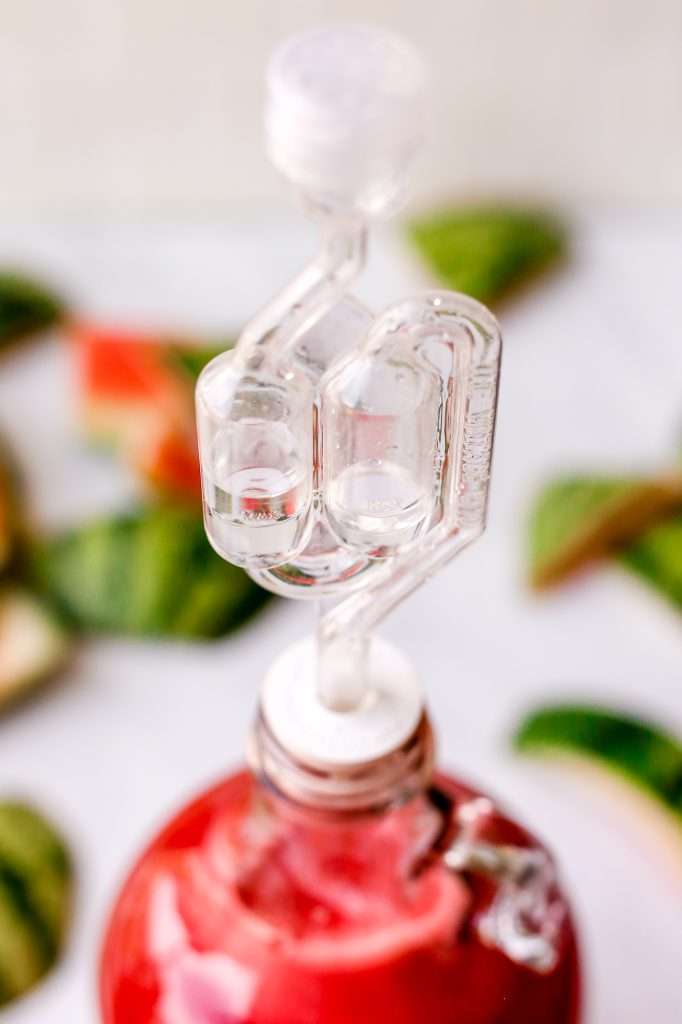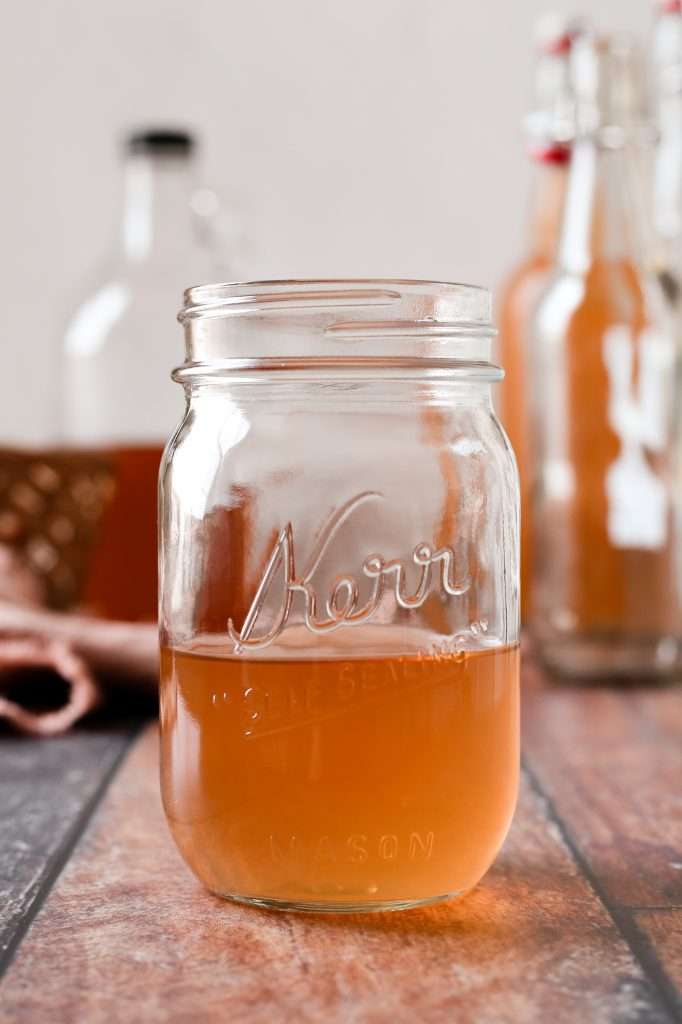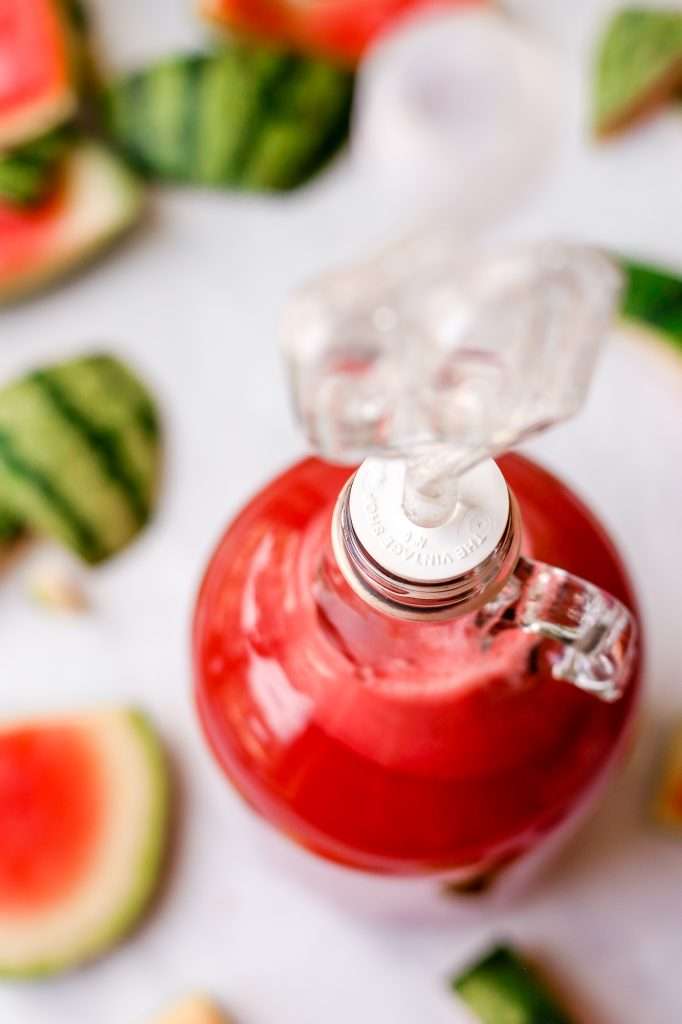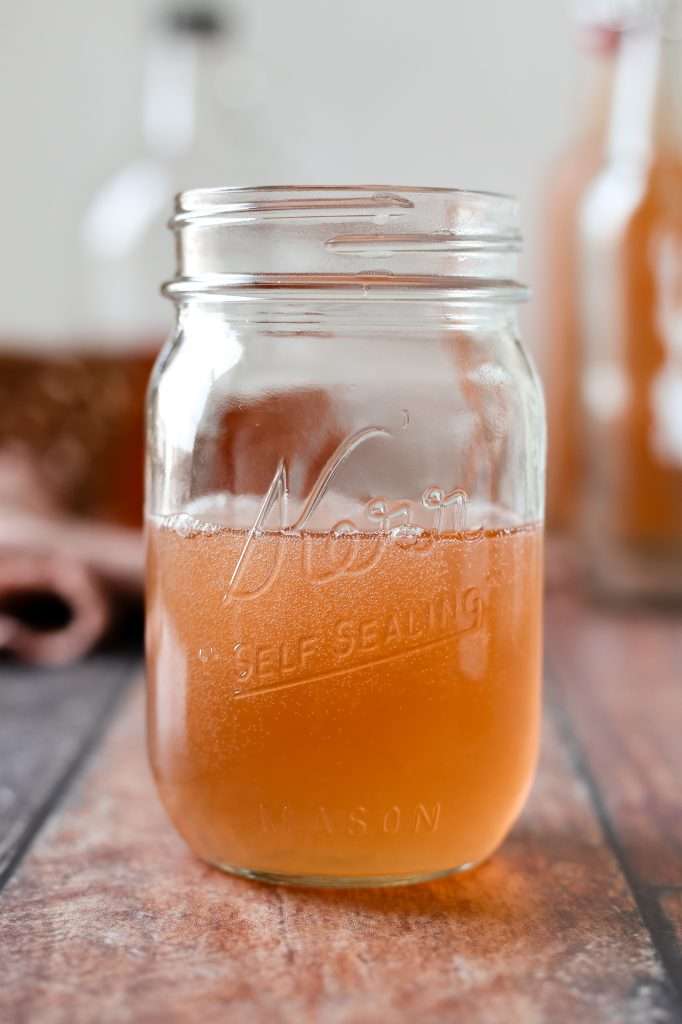Homemade Watermelon Wine
What should we call it? Is it watermelon wine, or is it watermelon mead?
It’s both! Mead is a specific drink that includes honey in the fermentation. Any fermented fruit beverage above 8.5% ABV is usually considered a wine. So this recipe is kind of a mix between the two. My recipe can be made with honey or with organic cane sugar, or a mix of the two, so what you call it can change depending on what sugar you use.
This wine is around 10% ABV, so it’s not as alcoholic as store-bought red wine. However, it will still give you a refreshing buzz on a hot summer day. (and you can add more sugar to increase the ABV if you want to). It’s the perfect wine for sipping on a front porch swing on a summer evening.

Watermelon Mead
Watermelon and honey are abundant in the summer, which makes watermelon mead the best drink to brew this summer. I usually enjoy this wine as a still beverage, but I have bottled it for carbonation with good results.
When bottling the wine, you can add more honey (also called priming sugar) to create a sparkling wine. Once the wine is done fermenting, it’s much lighter in color.
I love pairing this fresh watermelon wine with our Honey Butter Blackened Scallops with Couscous Salad on hot summer days.

How to Make Watermelon Wine with Honey
I think brewing at home intimidates many people, so I made this recipe as easy as possible.
With this recipe, you only need watermelon juice, water, strawberries, raw honey and some yeast.
I have a juicer and juiced my own watermelon juice. I’m not sure if you can find watermelon juice at the store, so plan on freshly juicing a watermelon.
The most important thing is that you need to filter the juice through fine mesh, like butter muslin. When making fresh juice, there can be a lot of pulp left in the juice, and that causes issues with the airlock when fermenting wine. So filter out all the pulp you can.
I incorporated strawberries for a more balanced flavor and color. You can use frozen berries, but I love making this when fresh berries are in season in Louisiana.
Here are the ingredients you’ll need:
- 2 Grams Cider Yeast (Saccharomyces bayanus)
- 48 fl oz watermelon juice
- About a pound of organic strawberries
- Filtered Water
- Organic raw honey

Wine Making Supplies
If this is your first time making wine at home, I highly suggest starting with a half-gallon recipe like this. This lets you get acquainted with the process and taste test before committing to a large batch.
Here is my Amazon list for brewing supplies. If you have a local home brew store, that is also an option to get what you need.
I got all my supplies at my local homebrew store up the street from my house. At a homebrew store, you can have someone help you pick out the right supplies and proper fitting airlocks. Please note that these links change sometimes, so you need to verify that the lids and airlocks you buy fit the jug you buy.
- 1/2 gallon glass jug (with a cap)
- a second 1/2 gallon glass jug (with cap)
- 1 rubber stopper for brewing – You will need to make sure it is the right size for your jug. Some jugs have different diameter openings. I’ve linked the size stopper that fits my 1/2 gallon glass jug.
- an S airlock for the stopper
- a funnel
- large pot for boiling
- cheap vodka (for cleaning equipment)
- Two 1-Liter swing-top bottles (carbonation safe, for bottling the wine)

Choosing Yeast for Watermelon Wine
You can use champagne yeast or cider yeast for all my cider and wine recipes. If you visit a home-brew store, they should be able to help you select a yeast.
When buying packaged yeast, I like to make sure that the yeast species is not genetically modified. We chose to use Saccharomyces bayanus. This yeast species is associated with the natural fermentation of grapes, and it’s great for any fruit wine fermentation.
Another option is to use wild yeast. You only need about two tablespoons of wild yeast starter in place of the yeast in the recipe. Click here to learn how to make a wild yeast starter.

How to Bottle and Carbonate Your Wine
Bottling and storing watermelon wine is pretty straightforward. You need to verify that you have carbonation-safe bottles.
To carbonate wine in the bottle, we have to add a small amount of sugar, called priming sugar, right before bottling. I like to use honey as priming sugar because it contains a lot of fermentable fructans. More fructans = more bubbles.
The yeast will feed on the freshly added sugar and produce more carbon dioxide. Since the wine is in carbonation-safe bottles with the cap secure, the CO2 is forced into the wine and becomes carbonated. Bottling 1 liter with only one tablespoon of honey is not enough sugar to excessively carbonate. It’s just enough to produce a pleasant level of carbonation.
To make this a still watermelon wine instead of sparkling wine, do not add any honey or sugar when you bottle it.
You’ll need:
- Two 1-Liter Swing top bottles(Carbonation Safe)
- Organic Honey
How to Bottle
- Clean and sterilize the bottles.
- Add one tablespoon of honey to each 1-liter bottle.
- Using a funnel, transfer the wine from the aging jug into the carbonation-safe bale top bottles, leaving the sediment in the bottom of the jug.
- Cap the bottles and invert gently twice to mix the honey with the wine.
- Allow to ferment at room temperature for five to seven days, then immediately place in the fridge. You can age the wine for three more weeks in the fridge before enjoying it chilled.

After fermentation, racking, and bottling with honey, the finished wine is much lighter in color and effervescent.
More Recipes to Try
- How to Make Sparkling Hard Apple Cider from Apple Juice
- Vinegar from Scratch
- Hard Blood Orange Cider Bottled with Honey


How to Make Watermelon Wine with Honey (Watermelon Mead)
Learn how to make watermelon wine! This recipe gives you a delicious home-brewed honey wine, also known as watermelon mead, with watermelon juice and strawberries, perfect for hot summer days.
- Prep: 1 hour
- Cook: 15 minutes
- Total Time: 1009 hours 15 minutes
Ingredients
- 48 fl oz watermelon juice
- 16 fl oz filtered water
- 350 Grams strawberries
- 2 tablespoons lemon juice
- 75 grams raw honey (or more)*
- 2 grams cider yeast
Instructions
- Clean and sanitize all of your equipment. I like to wash the jug with soap and water, allow it to air dry a bit, then rinse the jug with cheap vodka, and allow it to fully air dry.
- Once your equipment is prepped, add the strawberries and water to a pot, and bring to a simmer.
- Cook for about 15 minutes; while simmering mash the strawberries with a spoon.
- Remove from heat and place a fine mesh colander over a pitcher or bowl; strain out the strawberry pulp, reserving the liquid.
- Add the strawberry liquid to the 1/2 gallon jug with the honey and lemon juice and allow it to cool to room temp. (75 grams of honey will give you a moderately alcoholic drink. You can double the amount for a high-alcohol wine)
- Add in the yeast and mix gently by swirling. Wait about 30 minutes for the yeast to get frothy and active.
- In the meantime, juice enough watermelon to have 48 fl oz of juice. Strain all the pulp out of the juice using a fine mesh strainer and cheesecloth or butter muslin. You must strain ALL of the pulp out, or it can cause a big mess in the airlock.
- In a medium pot, heat the watermelon juice until simmering. Remove from heat and allow to cool to room temperature. (You can place a metal pot in a bowl of ice to cool it down faster).
- Carefully using a funnel, add the watermelon juice to the jug leaving two inches of headspace (see pictures above).
- Cap the jug and swirl it around for about a minute.
- Remove the cap and place the airlock and stopper in the jug (see pictures above).
- After a few hours, you should notice a lot of bubbling in the bottle and activity in the airlock.
- Allow the wine to ferment for 14 days until the bubbling completely stops and you no longer see any activity in the airlock. At this point, you should see a lot of sediment in the bottom of the jug.
- Racking the wine: Remove the airlock and using a funnel, transfer the wine to a new, clean jug for aging. Be careful pouring, pour gently and in one steady pour, leaving the sediment in the bottom of the original jug.*
- Cap the jug with a regular lid. Allow the wine to age at a cool room temperature or in the fridge for four weeks.
- At this point, you can rack the wine again with more aging time or move on to bottling.
- To Bottle the wine with honey: Clean and sterilize two 1-liter carbonation-safe bottles. Add one tablespoon of honey to each 1 Liter bottle. Using a funnel, transfer the wine from the aging jug into the carbonation-safe bottles, leaving any sediment in the bottom of the jug. Cap the bottles and invert gently twice to mix the honey in.
Allow to ferment in the bottles at a cool room temperature for five days, then immediately store in the fridge. (check the carbonation by carefully opening a bottle over the sink, if it is not carbonated enough you can leave it at room temperature for seven days.) - You can age the wine for three more weeks in the fridge before enjoying it chilled.
- Keep refrigerated.
Notes
- you can evenly sub the honey for organic cane sugar
- you can also use wild yeast in this recipe. You only need about two tablespoons of wild yeast starter in place of the yeast in the recipe. Click here to learn how to make a wild yeast starter.
- be sure to open the bottles to release the pressure occasionally when storing in the fridge for long periods. Bottling 1 liter with only one tablespoon of honey is not enough sugar to excessively carbonate. It’s just enough to produce a pleasant level of carbonation.





















Moro no Brasil e melancia aqui é abundante. Quero experimentar. Já experimentei fazer fermentação selvagem com a melancia, o gosto e o cheiro não ficaram bons. Confesso que sou principiante no assunto. Obrigada por suas postagens, além de todo o conteúdo doado, são lindos!
Does the yeast have to become frothy to ensure that it’s live as when making bread? Mine isn’t and I don’t want to proceed if it’s not good.
It may not be as frothy, but you should notice bubbles and activity within an hour if you test the yeast in some sugar water.
Just made this today! Excited to taste it when ready in a few weeks. Is this recipe easily subbed with other fruit juice or could I do all strawberries for strawberry mead? Thank you!
It’s easily subbed with other fruit juice!
I have started this process and today I have racked the wine (step 14). It did smell like wine! But it also had an unusual smell to it, like kinda floral but also kinda sour. Do you think this is normal?
Thanks in advance! I love your website 🙂
That’s how mine smelled too, it’s just the nature of watermelon wine.
Can you leave out the strawberry?
you can, but the strawberry adds a good depth of flavor.
I started this the other day and everything happened according to plan until about 36 hours into the ferment and it just stalled out. No more bubbles, no more frothy head, and some sediment on the bottom. What happened and how do I get it back up and running? I used champagne yeast, does that change things?
It should be fine, I use champagne yeast all the time and mine stops bubbling around five days sometimes, especially if its warmer in my home. You can go ahead and rack it, then add some more sugar (about a tablespoon) and it should restart bubbling.
Excited to try this one! Can the recipe be easily doubled to do a 1 gallon batch?
you can double the recipe!
Love this! How free can you be with fruit substitutions (a general question i have, but specifically here for the strawberries!). For eg, i found local blueberries but strawberries are tougher. What do i need to know before subbing fruits? Had the same question on blood oranges since they’re out of season 🙂
Thank you so much for your work here, huge fan!!
you can sub with any fruit you want, really. Blueberries will work great!
If you add the honey to carbonate it, it needs to be aged in the fridge, but if you don’t could you bottle it and place in a cool basement?
Yes, if you do not bottle with honey, and choose to make a still wine, you can age in a cool basement
Starting this recipe today and super excited! Just curious: are there any notes when fermenting? Like does it need to be left on the counter, in a dark room, etc.?
on the counter at room temperature. Lighting doesn’t really matter, just don’t put it in the sun. All the directions are in the recipe card.
Gosh, so excited to try this! What’s the shelf life of the wine please… do you test the alcohol content and can you control the alcohol content? Thank-you!
I’m wanting to make this recipe, but I can’t have strawberries. What fruit can I use in place of the strawberries?
sub the whole strawberry situation with apple juice!